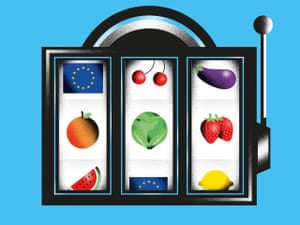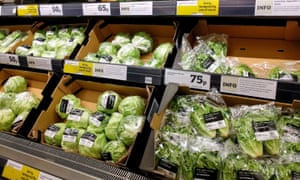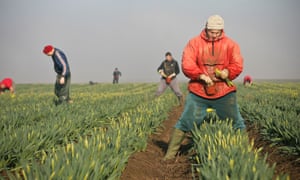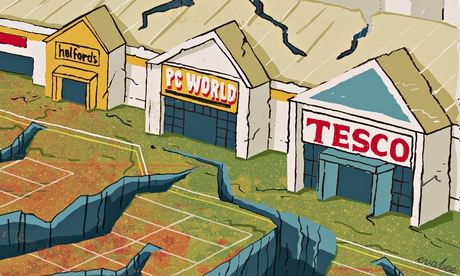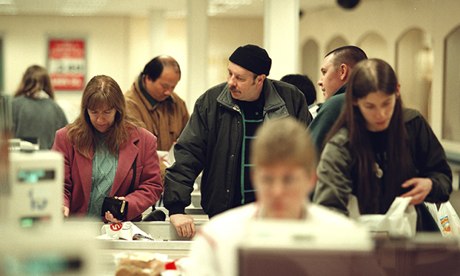On a Thursday morning in April 1990, in the suburb of Stechford in Birmingham, a strange grocery chain started trading in the UK. It only stocked 600 basic items – fewer than you might find in your local corner shop today – all at very low prices. For many products, including butter, tea and ketchup, only a single, usually unfamiliar brand was offered. To shoppers accustomed to the abundance of Tesco and Sainsbury’s, which dominated the British grocery sector with thousands of products and brands, delicatessens, vast fridges and aisles piled high with fresh fruit and vegetables, the range would have seemed dismal.
The managers of this new shop, which was called Aldi, had not bothered to place a single advert announcing its arrival – not even an “Opening soon” sign outside the store. Strip lights illuminated the 185 sq metre store, and from the ceiling hung banners listing prices for the goods stacked on wooden pallets or displayed in torn-open cardboard boxes on metal shelves. A £1 deposit allowed you to borrow a trolley but there were no baskets. The checkout assistants, who had been trained to memorise the price of every item in the store, were so fast that shoppers experienced what some would come to call “Aldi panic” – the fear that you cannot pack your goods quickly enough. The store accepted cash but not cheques or cards. Customers seeking itemised receipts left disappointed.
Information on Aldi’s owners was as limited as the decor. Most news reports noted merely that the company belonged to a frugal and spectacularly rich pair of German brothers, Karl and Theo Albrecht, who had both fought in the second world war and whose desire for privacy had reached extremes after Theo’s high-profile kidnapping for ransom in 1970s. The Albrechts had an extremely popular chain of bleak discount stories in Germany: the brothers had divided the country into separate fiefs, with each controlling the market in one half of the territory.
But most people were confident they would fail in Britain, where there was a discernible snobbery about discount stores. When a reporter from the Times visited an Aldi store in Birmingham the following year, he thought it represented the “anonymous, slightly alarming face of 1990s grocery shopping”, without any pretence of sophistication. “One looks in vain for avocados or kiwi fruit.”
The British supermarket giants, whose 7% profit margins were the world’s highest, were even more dismissive. Sainsbury’s remarked on the absence of service, which was important to British customers. “We welcome the advent of Aldi and others to come,” said Tesco managing director David Malpas. “We can live quite happily in our part of the market and they can live in theirs.”
For a long time it looked like he was correct. In 1999, when Walmart bought Asda, the UK’s third biggest grocery chain, the Financial Times noted that Aldi had made “little impact in Britain” because customers were not as price-sensitive as Americans or continental Europeans. German shoppers, notoriously, took this to extremes: one of the country’s biggest electronics retailers, Saturn, even adopted “Thriftiness is sexy” as a marketing slogan. By 2009 – after nearly two decades – Aldi’s market share was just 2%, similar to that of Lidl, its German rival and imitator, which had launched in Britain soon after Aldi.
But today, the boasts of Tesco and Sainsbury’s read like a classic example of business hubris. While the major supermarkets dozed, convinced that many people would not be seen dead in a discount store, the German chains quietly turned the sector on its head. Nearly two-thirds of households now visit an Aldi or Lidl branch at least once every 12 weeks, according to the research firm Kantar Worldpanel.
In 2017, Aldi overtook the Co-op to become the UK’s fifth largest retailer; today it has a 7.5% market share, closing in on fourth-place Morrisons, with 10.6%. Lidl has 5.3%, more than Waitrose. What’s more, the two discounters are still growing quickly – opening an average of one new store every week, often in more affluent towns.
By sucking in shoppers and, as former Aldi UK CEO Paul Foley puts it, “sucking the profitability out of the industry” – profit margins of 2-3% are now the norm – the two German-owned companies have forced the “big four” supermarkets to take drastic measures. Morrisons has closed stores and laid off workers, while Sainsbury’s and Asda, desperate to cut costs and stop losing market share, announced a proposed £13bn merger in May, which the UK competition watchdog now appears likely to block. Tesco, meanwhile, has slashed its product range and bought the discount wholesaler Booker. In September, in a belated acknowledgement that the major threat to its business comes from Aldi and Lidl, Tesco launched its own discount chain, called Jack’s.
These industry shifts often lead the news, because supermarkets are so important to the economy: with more than 300,000 staff, Tesco is the UK’s biggest private-sector employer and the biggest retailer of any sort. But we also follow these stories closely for a more sentimental reason: grocery shopping is an intimate part of our lives. We don’t need to buy books or fancy trainers, but we do need to eat.
Most of us shop weekly, at the same store each time. Traditionally, we chose a shop for convenience – because a particular store was close by and because we knew along which aisles to find a large choice of our favourite products and brands – and loyalty. Research shows that many of us also chose a grocer because of how we perceived ourselves in terms of class and status. In the early 2000s, before Aldi’s rise, Peter Jackson, professor of human geography at the University of Sheffield, noted that British shoppers appeared to want an “environment where they will be surrounded by people like themselves” with whom they feel comfortable.
But the success of Aldi and, to a lesser extent, Lidl, shows that these old conventions no longer hold so true. Aldi, which is still family owned and unburdened by the short-term pressures for profits faced by its stock-market listed rivals, has changed the way we shop.
Today, you will no longer search in vain for avocados and kiwi fruit at Aldi. You will even find sourdough baguettes, prosecco and 36-day aged Scottish Aberdeen Angus sirloin steak, the sorts of items that have attracted customers who previously might have looked down their noses at discount shops. But there’s still only one type of ketchup (45p a bottle). The total number of products – known in retail as stock-keeping units (SKUs) – found in all Aldi stores has tripled since the early 90s to nearly 2,000, although that remains tiny compared to the 25,000 or more in a big supermarket. Most of these products are private labels that are made specifically for the company, even if they are designed to appear familiar to shoppers. In the chocolate aisle you will find Aldi’s own version of Mars and Snickers bars (“Titan” and “Racer”) – although its long struggle to copy the KitKat ended in failure.
The stores’ overall feel is still more gritty than pretty. In the latest Which? magazine survey of its members’ favourite supermarkets, published in February, shoppers ranked Aldi third overall, behind only Waitrose and Marks & Spencer, despite giving it only one star out of five for store appearance. Merchandise is still displayed on pallets, in plastic crates or cardboard boxes – or arranged haphazardly, as in the case of the one-off, bargain-priced goods found in the “middle aisle”, which hosts a rapidly rotating assortment of ultra-discounted oddities.
The famous “middle aisle” is the one place in Aldi where people linger for more time than is absolutely necessary, and it inspires devotion among customers, who know it by an assortment of made-up names: “the WTF aisle”, “treasure aisle-land” and, my two favourites, “the Aisle of Wonder” and “the Aisle of Shite”. You might find yourself walking into Aldi for coffee, pasta and milk and walking out with a discount welding helmet, an inflatable watermelon or a blanket for a horse (even though you don’t own a horse).
As anyone who has tried navigating a ram-packed Aldi on a Saturday afternoon will know, you still don’t go there for the ambience or relaxed shopping experience. “Aldi panic” at the till endures in the electronic age thanks to a simple innovation that allows for instant scanning of goods. Packaged products in all supermarkets come with a barcode, which the checkout assistant will locate and scan. But look closely at a packet of Aldi toilet rolls and you will see not one but four barcodes: two long ones down the sides, and one on each large flat surface. A container of butter has three barcodes; a bag of carrots has two. For kidney beans, a pinstripe barcode is wrapped around half of the can. This means that whichever way the assistant holds the product the scanner will register it.
For Aldi, the panic and rush is an integral part of the shopping experience for two reasons. The first is the happy realisation once you have left the store, and your heartbeat has settled, that you have spent less time shopping than you would have in a typical supermarket. The second, and most important, is what Aldi managers describe, straight-faced, as “the thrill at the till”: your trolley full of goods has cost less than you thought it would. The rushed, no-frills experience isn’t something you merely endure for the sake of saving money; the awareness of your savings makes that experience a pleasure in itself.
“When you leave the store, Aldi wants to think you have paid nothing for the aesthetics – it all goes into the low cost,” said Richard Hyman, a retail expert who has followed the company since it launched in Britain.
That this appeals to such a range of customers – look at the cars outside the next time you visit – shows just how successful Aldi has been in disrupting the supermarket sector, without changing its own business model. Other companies that have upended industries, such as Amazon with books and Uber with taxis, have relied on new technologies – the internet, the smartphone – as the disrupting force. Aldi is still relatively low-tech: without a loyalty programme, it knows little about individual customer preferences and you can’t buy its groceries online. What it has done is disrupt a mindset: the settled wisdom about how we think of ourselves as shoppers, and the basis by which we identify with a particular supermarket. Aldi’s victory was to show that there was no shame – and in fact there was satisfaction – in shopping at a discount supermarket. British mums once worried about their children being embarrassed to find Aldi food in their lunchboxes; now they happily swaddle their babies in Aldi’s disposable nappies, which are now the second-most popular brand in the country, behind only Pampers. “Aldi’s customer profile is now classless,” said Hyman. “The supermarket is as strong with affluent people as it is with people on low incomes.”
Karl Albrecht, who was famously secretive, only spoke publicly about Aldi’s business model on one occasion – in 1953. Its fundamental principles, he said, were “narrow product range and low price, [which] cannot be separated”. It was a strategy his mother, Anna, had followed, when she opened a small grocery store in 1913 in Essen, in western Germany, after her husband had developed emphysema working in the coal mines. Karl and Theo, who were born in the early 1920s, helped in the shop before being conscripted into the army when the second world war broke out. Karl was wounded on the eastern front and later captured. Theo fought in Rommel’s Afrika Korps before being taken prisoner in Italy in 1945.
After the war, the brothers returned to Essen to find the city devastated by allied bombing but the grocery store undamaged. They took over the business, expanding it into a network of small shops. Lacking capital, they stocked only a tight range of staples, such as pasta and soap, planning to widen the offering later. But they soon realised that offering a limited selection of cheap, fast-selling goods kept their costs down and the cash flowing, which they could use to invest in new stores. As the former Aldi executive Dieter Brandes and his son Nils wrote in “Bare Essentials”, their book about the company: “Basically, a completely new business model was created along the lines of a discovery in the natural sciences: by accident.”
Germans, forced into frugality during the war, remained thrifty, and would line up outside the Albrecht stores before opening time at weekends. The chain’s popularity grew further when the brothers decided to adopt the model established in the US by the Memphis grocer Piggly Wiggly (and its imitators, Hoggly Woggly, Helpy Selfy and Handy Andy), launching Germany’s first self-service store in the mid-1950s. Instead of clerks filling orders from behind a counter, customers were able to pick the goods themselves, speeding up the shopping process.
Although they were close, the Albrechts were independent-minded and did not agree on everything. Theo wanted to stock cigarettes, for example, but Karl thought it would attract shoplifters. And so, in 1961, when they had 300 stores, they chose to split Aldi, short for Albrecht Discount, into two parts. The “Aldi equator” ran through Essen, with Theo taking the part of Germany to the north, and Karl the south. Aldi North and Aldi South shared all information, except profits, and conducted some supplier negotiations jointly, but were otherwise run separately, with their stores carrying different product ranges and featuring differently coloured floors – one yellow and one grey.
The brothers had always kept a low profile, but the success of their business did not go unnoticed. In December 1971, while preparing to drive home from work, Theo was kidnapped at gunpoint. His abductors were an unlikely pair: a convicted burglar nicknamed Diamond Paul and his lawyer, who had gambling debts. At first they were unsure that the ordinary looking man in the ill-fitting suit was really their target, and demanded to see Theo’s identification documents. The men kept him hidden in a wardrobe in Dusseldorf for 17 days, during which time Theo haggled over his ransom of DM7m (£1.5m at the time), for many years the highest ransom paid in Germany. The cash was delivered by a mediating bishop from Essen, with Karl contributing half.
Diamond Paul and the lawyer were soon caught, convicted and sentenced to eight-and-a-half years in prison. Only half the money was recovered. Theo later tried, unsuccessfully, to have the ransom written off as a business expense for tax purposes.
Following the media coverage of his release, he never permitted himself to be photographed again. He travelled to his office in an armoured car by a different route each day, and when checking into a hotel, ascertained the best escape route before even going to his room. But Theo continued to put in long hours at the office, managing even the smallest details in his quest to save money. He wore pencils down to the nubs and turned off the light when entering an office if he judged that his staff could see well enough without it. He once told his board to look at the thickness of the paper used for photocopies. Outside consultants and media interviews were banned, considered unnecessary expenditures or distractions. Asceticism was a virtue in life and business, he believed. “People live more on what they do not eat,” he once said. He wanted Aldi to be a place where “people who don’t hate their money can safely go shopping”.
Karl was more charismatic and less intense than his brother, making time daily for an afternoon nap and to read for 20 minutes, usually biographies and memoirs, with Churchill a favourite subject. But, like Theo, he was fiercely demanding of his employees. Stagnation was unacceptable. Aldi managers were expected to make continuous improvements to the company’s processes, a business philosophy also used by Japanese manufacturers, where it was called kaizen. In their book “Bare Essentials”, Dieter and Nils Brandes argued that Aldi’s embrace of kaizen, its lean management structure and just-in-time approach to inventory – taking delivery of stock only when needed, to cut holding costs – made it the “most Japanese” company in Germany.
By the early 1970s, the brothers were ready to test their model abroad, initially in Europe and then in the US. In 1976, Aldi South, Karl’s company, opened the first Aldi store on the east coast of the US. Three years later, in 1979, Theo’s Aldi North purchased Trader Joe’s, a California chain that sells cheap gourmet foods and enjoys a cult-like following. (The US is still the only foreign market where both Aldis operate.)
In the UK, at that time, Tesco and Sainsbury’s were fighting a price war. But as the 80s went on, the big supermarkets stopped competing on price when they realised they could both make much more money by expanding: instead, they concentrated on buying land and building superstores to encourage customers to spend more. Their profit margins surged. For Aldi, the record profits of the big grocers, along with a recent cut in corporation tax, made the UK a very attractive opportunity. With the US launch now complete, and Aldi senior management free to tackle their next big challenge, Karl Albrecht decided the time was right to bring the company to Britain.
The big British supermarkets didn’t take Aldi’s threat seriously at first. But they – and their suppliers – did not make things easy for the German interloper. Within months of opening the store in Stechford in 1990, Aldi had raised a complaint with the Office of Fair Trading. Quaker Oats was refusing to sell to Aldi at all, while Whitbread, the brewer, had expressed concern over the discounter’s “open aggression on prices”. Cornflakes had to be sourced from France. Aldi blamed the supermarkets for putting pressure on the suppliers.
“The rest of the industry hated us,” said Paul Foley, who was the company’s third employee in the UK, and chief executive from 1999-2009. “I heard us called parasites, leeches, and ‘a plague of locusts landing on our shores’” – because of the company’s record of dragging down prices and profit margins in new markets. “It means nobody will help you: nobody wants to rent you space, organise transport for you, or sell you product.”
Still, Aldi believed eventual success was a “racing certainty” because all the conditions it looks for in a foreign market were present, Foley told me. First, large supermarkets dominated the grocery industry, with no big “hard discount” retailer present. Second, the main chains – the big four as well as the leading “soft” discounter Kwik Save (which stocked a larger range than Aldi) – were listed on the stock exchange. The best way to fight Aldi early on is to slash prices, but few bosses of public companies are happy to accept lower profits, and thus lower bonuses, by pursuing long-term strategies.
Third, the UK is a wealthy country, where most people are unwilling to compromise on the types of food they eat. “In rich nations, the postman and the hedge-fund manager have almost the same basic diet,” Foley said: cereal, bread, cheese, beer, ketchup and so on. That is important for Aldi or Lidl because ultimately they look to develop their own products to rival established brands, without shoppers being seduced by cheaper, substitute foods they don’t stock.
Fourth, and most importantly, the UK is, by global standards, a high-wage economy. This means that labour costs make up a big part of a supermarket’s operating expenses. Here, discounters have a major competitive advantage, because their business model – stocking a small range of products, eschewing delicatessens and promotions, and so on – allows them to operate with fewer, more productive, staff. (The most important performance measure in any Aldi branch is revenue divided by employee hours.) At Aldi there are no dedicated checkout clerks but rather “all-rounders” who work the tills when needed but also clean the floor if there is a spill, and bring merchandise from the stockroom on to the shop floor. Replenishing the shelves is much faster than at other supermarkets because the products are displayed in the boxes they arrived in, rather than arranged by hand. Tesco founder Jack Cohen famously gave his top managers tie-pins with the letters “YCDBSOYA” – “You can’t do business sitting on your arse”. In Aldi, no staff member ever sits on their arse.
When entering a new market, Aldi seeks to magnify this labour-cost advantage in a counterintuitive way: by publicising that it will pay its store staff better than other supermarkets. Today, new Aldi store assistants receive industry-leading pay of £9.10 an hour, and £10.55 an hour in London – the London living wage – while a graduate accepted on to the area manager programme starts on £44,000 and gets an Audi A4 company car. Paying well obviously helps attract and retain staff, who might otherwise go to chains where the pace of work is slower. But it also serves to drive up wages across the industry, which, because of Aldi’s lower overall employee costs, hurts its competitors more.
In those early years, in the 1990s, the company focused on the Midlands and the north of England, where store rents were cheaper, and the customers less affluent, deliberately staying away from London and the south-east. As a private company, with no shareholders other than Karl Albrecht’s family to answer to, it could afford to be patient. “Aldi is very attuned to going into a country, making the investment, and building slowly and steadily,” said Richard Hyman, the retail expert. “Most other companies don’t have a 30-year view – or even a five-year view.”
The fortunes of its bigger competitors varied. Kwik Save foundered and eventually went under. Tesco, which was building an empire of out-of-town superstores, overtook Sainsbury’s to become the leading grocery chain. Profits at the big four remained healthy in the 21st century, even as they chased new streams of revenue: expanding abroad, and launching online shopping, banking and mobile-phone services. Aldi and Lidl were still seen as niche retailers, locked out of the mainstream market.
Then, in 2008, the door blew open. Northern Rock was nationalised, Lehman Brothers collapsed and the global economic crisis began. Inflation rose above 5%. Companies laid off staff. Household incomes were squeezed. But the big grocery chains actually raised their prices in line with inflation, to try to maintain their profit margins. “Consumers needed to save money, but rather than recognise the challenge, the bosses of the big four supermarkets decided to milk inflation,” said Clive Black, head of research at Shore Capital. “People were forced out of necessity to try the discounters.”
For Aldi, the timing was fortunate, as it was just reaching critical mass in the UK. It had about 400 stores, and an established network of manufacturers delivering products that were not only low-priced, but also of a reasonable quality. A new phase of rapid growth was inevitable, Aldi’s managers believed; the financial crash brought it on sooner than expected. “Shoppers realised that Aldi was cheap, but not as nasty as they had thought,” said Black. “The service level was simple but efficient. The stores were not too big. And a lot of people shopping there were their neighbours.”
As their sales slowed, the big supermarkets looked for other ways to maintain profits. Charging suppliers to stock their brands, and to promote them if sales reach a certain volume, is standard practice at all big grocery chains. A washing powder manufacturer might, for example, pay hundreds of thousands of pounds to a retailer to have its detergent displayed in the best position – the end of the aisle – where sales can increase as much as tenfold. This income from suppliers, which reduces the cost of goods sold, is known as the “back margin” – the “front margin” comes from selling to the customer – and can mean the difference between reporting an overall profit or loss. At the time, Tesco had 24 different ways of extracting money from suppliers.
Now, the big supermarkets pressurised suppliers to increase these back-margin payments. As a result of Tesco’s desire to boost its fees from stock listing, the number of products on its shelves shot up to as high as 90,000, as did the number of promotions. The company appeared to be as much in the brand advertising business as the grocery business. British consumers, who on average buy fewer than 20 items on each trip to a grocery store, were confused by the huge choice and the up-and-down prices. Even more took their wallets to Aldi and Lidl, some just for the essentials but others for the bulk of their weekly shop. (Most discounter customers still do a top-up at a big supermarket.)
By the time the supermarkets awoke to the structural shift that had occurred in the industry, the damage was done. “The big four bosses were not just sleeping at the wheel,” said Black. “They were comatose.”
In recent years, Aldi has worked very hard to widen its appeal among British shoppers. One morning in October, I drove to Staffordshire to talk with Jonathan Neale, who joined Aldi as a graduate in 2002 and is now managing director of buying. We met at one of the company’s flagship stores in Tamworth. When I mentioned my nearest branch, in Oxford, with its narrow aisles and awkward layout – bread in the first aisle, so it gets squashed in your trolley – Neale winced. Newer and refurbished shops, like the Tamworth one, are brighter, with wider aisles and more space for fresh and chilled food, which appeal to more upmarket customers.
Neale mentioned some of the other changes introduced in all stores to attract more business: five years ago Aldi introduced shopping baskets and started accepting credit cards, and two years later it introduced a small range of newspapers and magazines. It is also following trends more, selling things like manuka honey, protein bars and chia seeds. A caviar-based skincare cream proved hugely successful, and resulted in loads of free advertising: a Daily Mail article ran under the headline “The £7 Aldi moisturiser that’s (nearly) as good as a £292 cream”.
“Ten years ago we had 900 lines, now we have 1,800,” said Neale. “That’s not because we are trying to become a big-four retailer, it’s because consumer tastes have evolved. We are managing the equilibrium between what customers want and costs.”
Ultimately though, cost remains the most important consideration. When it comes to buying groceries online, Britons are tied with Japanese in second place, behind only the South Koreans. But Aldi still has no plans to sell food through its website. (You can buy wine and “middle aisle” products there.) As the large supermarkets have realised, it is very hard to make money from internet sales because the profit margin on groceries is small and the delivery costs are so high – but now they can’t reverse course without losing customers. Andy Clarke, the former boss of Asda, told the Sunday Times last year that if the big four supermarkets had their time again “they wouldn’t have offered home deliveries, full stop”. “Online groceries are a cost drain,” Neale said. “Why should 90% of customers subsidise the 10% who get free home delivery?”
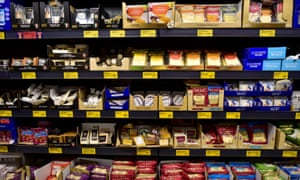 A range of cheese on display in Aldi. Photograph: Peter Summers/Reuters
A range of cheese on display in Aldi. Photograph: Peter Summers/ReutersAs we walked through the aisles, a few familiar brands stood out, such as Marmite, and Colgate toothpaste. Nobody has yet managed to launch a successful private-label yeast extract product, Neale said. “And we tried with a private-label toothpaste, but our market data showed us we needed a brand.”
You can also buy Nutella and Coca-Cola, although alongside them you will find Aldi’s own chocolate spread, Nutoka, and its own cola, at much lower prices. All supermarkets have their own private labels: made not by them, but for them, by manufacturers who agree to put their merchandise in a bag or box with the grocer’s logo on it. But Aldi takes this to extremes: more than 90% of the products it sells, from shaving cream to dark chocolate and frozen pizza, are private labels. Some, it gets from suppliers that only produce private-label goods, which they may sell to several different supermarkets. Other merchandise comes from companies that also make branded products, and the occasional error, like when an Aldi customer found a packet of Hula Hoops inside a multi-pack bag of the discounter’s Snackrite hoops. This invariably makes the news, and gives Aldi free advertising.
Stocking mostly own-label goods allows the company to order huge quantities of a single item, to its own specifications, at a low unit cost. Consider ketchup. If a big supermarket orders ketchup, that may be spread among three or more suppliers that each have several different pack sizes and formulations, such as plain, reduced sugar and salt, and organic. Aldi’s entire ketchup order comes from one manufacturer that can operate the same, unchanging product run, all the time, and has no marketing costs to build into the price. “For many SKUs we are the biggest buyer by a country mile,” Neale said.
Similar economies of scale apply to the merchandise in the ever-changing Aisle of Wonder/Aisle of Shite. Most supermarket buyers look for suppliers that keep their shelves stocked year round. Because the goods in this section are one-offs, rather than always kept in stock, Aldi can place a bulk order for delivery at its distribution centres around the country on a specific day. Its buyers look at market trends and then seek out manufacturers with spare capacity or excess stock, anything from champagne to knitting wool and cycling accessories.
Aldi’s low prices on everything from fresh fruit to crisps have led people to question “where we are cutting corners”, Neale said, to which he replies that they aren’t. Among UK suppliers, who have often been treated badly by the big supermarkets, with their pressure for back margin fees and slow payment terms, Aldi has a good reputation. But the company has been criticised for a lack of transparency about its global supply chain. In September, Oxfam ranked British supermarkets according to their “public policies and practices that prevent human suffering” among the workers and farmers who produce their food abroad. Aldi was bottom of the list. (In a statement, the company said: “We respect human rights and have comprehensive checks in place to ensure that everyone in our supply chain who makes, grows and supplies our products is treated fairly … We continue to have positive discussions with Oxfam.”)
When we reached the tills, Neale explained how the multiple barcode strategy helped get customers through quicker. In fact, the whole checkout area is designed for speed. The conveyor belt is long enough to unload a full trolley. But the packing area behind the cashier is so small it can only hold a few items. This is to encourage customers to put their scanned purchases straight back into the empty trolley. Only after paying and pushing the trolley to a counter at the front of the store are you meant to transfer your purchases into carry bags.
I had heard that the rate at which individual employees scan items at the checkout is closely monitored. Neale confirmed this, although he would not be drawn on the targeted number of scanned products per minute, and said that staff were instructed to assist customers who struggled to keep up.
Aldi UK’s corporate headquarters is in Atherstone, about 15 minutes drive from the Tamworth store. A long row of delivery lorries were parked next to an adjoining warehouse, their sides emblazoned with giant Union Jacks and the slogan “Championing Great British quality”. In the reception, a television had on repeat an advert featuring the Olympic triathletes, Jonathan and Alastair Brownlee, who Aldi sponsors, along with Team GB. Lidl, the “official supermarket” of the England football team, has a similar marketing strategy. Fraser McKevitt, head of retail at Kantar Worldpanel, said the strategy of trying to appear more British – as well as adopting more local business practices, such as accepting credit cards – had been effective in helping both companies grow their market share.
From the Aldi reception I followed Neale to one of the most crucial parts of the company’s operations, the testing rooms. Because Aldi stocks so few items, compared to the big supermarkets, it must constantly “forensically examine” all its products against competitors’ merchandise to ensure they stack up, Neale said. In one room, a team was looking at fruit juices and sports drinks. Aldi had asked a supplier if it could develop a paper straw, for environmental reasons, but was told it was not yet possible. Now, another grocer was selling juice with a paper straw, and the buyers were scrambling to find a way to catch up. In another room, a team was looking at brioche burger buns, of which Aldi has 20% of the UK market, Neale said. Two managers from the bakery department were comparing buns purchased from Jack’s, Tesco and Sainsbury’s, with Aldi’s buns, which are baked by a French company and part of its growing “Specially Selected” range of premium products. Neale picked up the Jack’s brioche buns, and noted that they were made locally. “Great – but you know what? I’d prefer mine made by the experts in France,” he said.

FacebookTwitterPinterest Karl Albrecht in 2006. His brother, Theo, never allowed himself to be photographed. Photograph: AP
On another table stood a box of Marks & Spencer apple and cinnamon flakes. Aldi buyers, whose job includes identifying popular items it does not stock and quickly bringing them to market, wanted to see if it was worth making something similar. When copying a branded product, the mimicry often extends to the name and packaging. Aldi sells a cheap, spreadable butter called Norpak, for example, which resembles Lurpak, and Wheat Shreds, in a box that looks like Shredded Wheat.
The large consumer goods companies don’t like this, of course. Paul Foley, the former Aldi CEO, who now runs his own retail consultancy, often tells his clients about his attempts to replicate a KitKat in the 1990s. It turns out this is really hard to do without the chocolate making the wafer soggy. Eventually, Aldi gave up. Foley asked his buyer to contact Nestlé’s UK office to announce Aldi’s surrender and request to stock KitKat. Nestlé would not return his call. So Foley ordered the bars from Germany, where they have a slightly different taste. Soon, Nestlé UK starting receiving complaints about the taste of its KitKats, and traced the problem back to Aldi. When they phoned Foley to complain, he “politely refused to cooperate”.
Aldi vs Nestlé, both huge, global companies with big legal teams, may seem like a fair fight. But Aldi has also got into trouble for appearing to copy the packaging of smaller British brands. In 2014, Aldi was forced to settle a high court case brought by The Saucy Fish Co, a Grimsby-based seafood producer, after the supermarket introduced a copycat product called Saucy Salmon Fillets. This year, the discounter has faced complaints from artisan yoghurtmaker The Collective and the family-owned sausage brand Heck, for selling cut-price look-a-like versions.
Aldi claims that its customers shop there specifically because of its own-label brands, which are packaged in a way that makes them “easily recognisable”. “We go to great lengths to ensure that we adhere to strict copyright guidelines,” the company said.
Many in the industry disagree, saying customers are being duped. David Sables, CEO of Sentinel Management Consultants, which advises suppliers on how to deal with retailers, told me: “When an own label comes in the shape of something that looks and feels like the brand, to rip that off: I would view that as theft.”
In his late 70s, Karl Albrecht bought eight cemetery plots in a graveyard in Essen for himself and his family. Soon after, Theo purchased 14 plots there and, like his brother, left them untended, allowing weeds to grow. The cemetery administrator was compelled to write to the Albrechts, reminding them of their responsibility for maintenance. Finally, an Aldi truck arrived with yew trees, cypresses and rhododendrons – the brothers had been waiting until Aldi had plants on sale. Der Spiegel recounted that anecdote in 2010, following the death of Theo, which it said brought to an end “the story of the most eccentric, secretive and mysterious pair of siblings in Germany’s post-war economic history”. Karl died four years later, the richest man in Germany with a net worth of $25bn. (Second on the list was Dieter Schwarz, the Lidl owner, followed by Theo’s heirs.)
Although the founders’ families still own Aldi North and South, their influence over the companies’ direction is receding. Executives now run the business. Some experts say that as Aldi’s product range increases, it is becoming more like the supermarkets it seeks to undercut. “The Aldi DNA is still strong, but not as strong as it was,” Nils Brandes told me.
Even so, sales and market share continue to soar. In 2017, Aldi South’s revenues reached €52bn, with about 20% of that from the UK and Ireland. In Ireland, Aldi has 12% of the market, and in Australia 13%, behind Woolworths and Coles. Its share in the US is only 2% – but Aldi plans to raise its number of outlets from 1,800 to 2,500 by 2022, which would make it the third-biggest chain in the US by store count, after Walmart and Kroger.
In the UK there is still plenty of room to grow. Aldi hopes to have 1,000 shops in three years, up from just over 800 today. Dave McCarthy, a retail analyst at HSBC, said that given Aldi and Lidl’s expansion plans, their share of the market could peak at more than 20%.
Aldi is increasingly focusing on moving into wealthier areas in the south-east, including Sevenoaks, in Kent, which has a Lamborghini dealership and two Waitroses. This strategy is a sign of the confidence of Aldi – and Lidl, which already has a store there – that the sociology of shopping in Britain has shifted for good.
Five years ago, David Cameron was criticised when he claimed that customers in Waitrose, where he shopped, were “very talkative, engaged people” – far more so than at other supermarkets. Observers interpreted him as saying they were nicer, and more middle class than at other stores. (On other occasions, Cameron was more alert. Asked, during election campaigning, to name his favourite supermarket, he said, very slowly: “Not Waitrose.”)
When Aldi opened the doors of its new Sevenoaks store for the first time at 8am on a late autumn morning, there was already a long queue outside. James McSharry, who had arrived at 6.30am, was at the front, with his 14-year-old daughter, Aislinn. McSharry, 52, very talkative and engaged, worked in finance for JP Morgan for 20 years before retraining as a physiotherapist. He used to shop at Waitrose and Sainsbury’s, before switching allegiance to Lidl, buying 80% of his groceries there. Now he was eager to see what Aldi had to offer.
